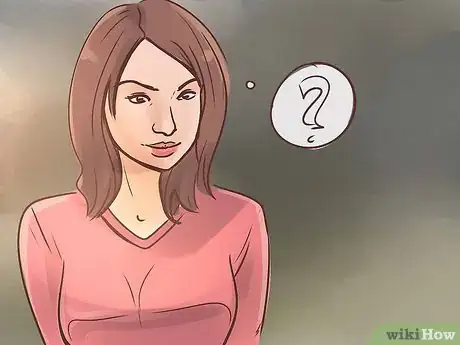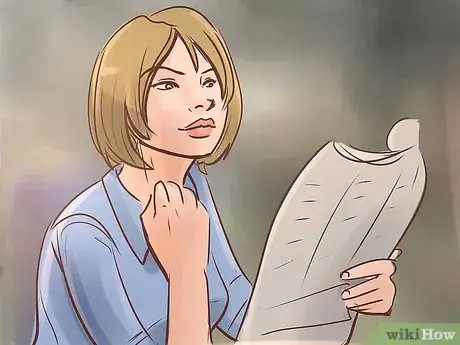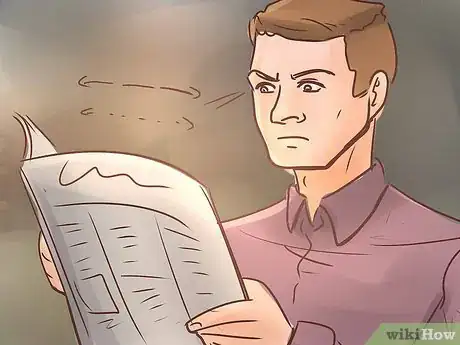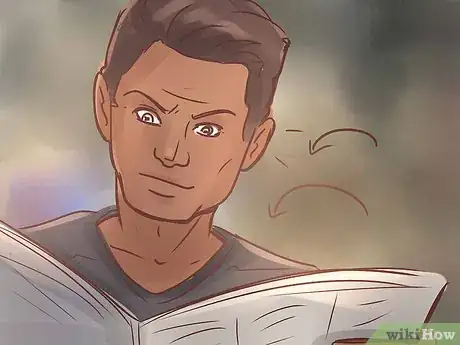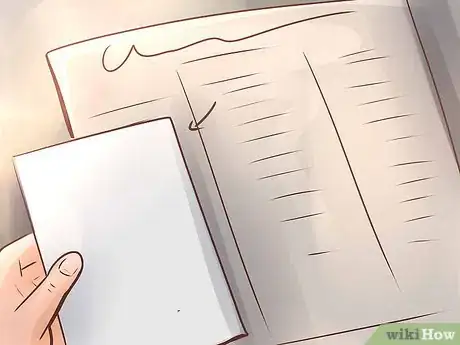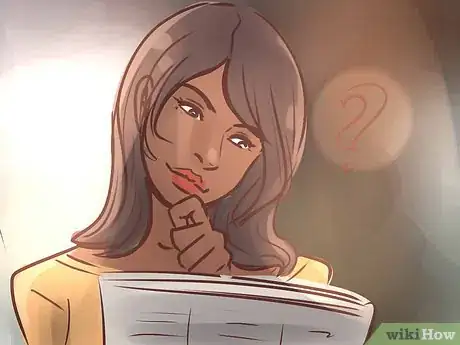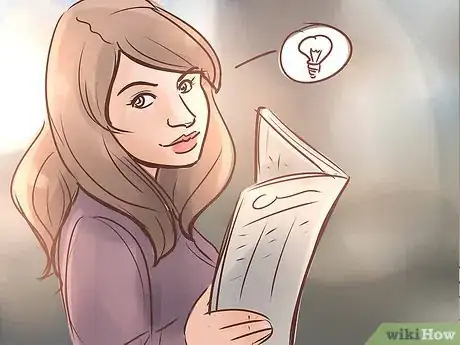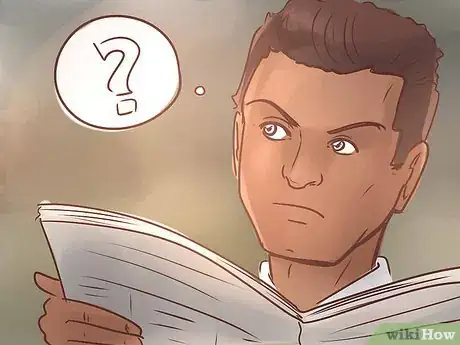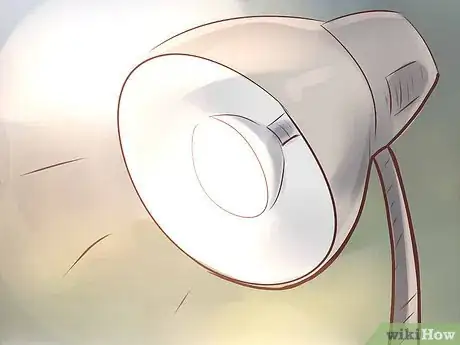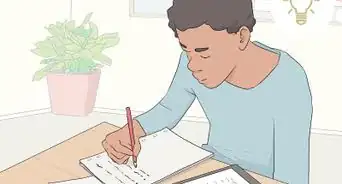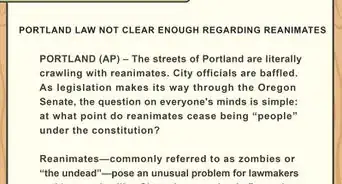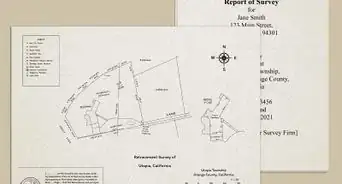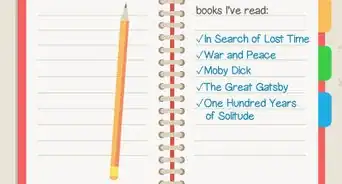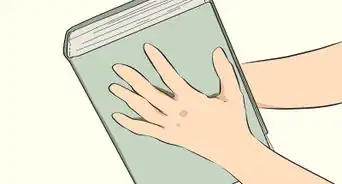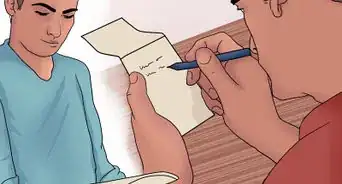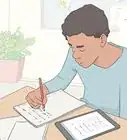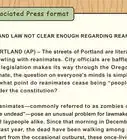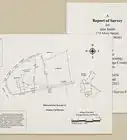This article was co-authored by wikiHow Staff. Our trained team of editors and researchers validate articles for accuracy and comprehensiveness. wikiHow's Content Management Team carefully monitors the work from our editorial staff to ensure that each article is backed by trusted research and meets our high quality standards.
wikiHow marks an article as reader-approved once it receives enough positive feedback. In this case, 86% of readers who voted found the article helpful, earning it our reader-approved status.
This article has been viewed 116,121 times.
Learn more...
Thick newspapers can be intimidating. While you want to read the full paper to stay caught up with current events, you may wonder if you have the time. There are many ways you can get through a thick newspaper quickly. Go in with the right mindset. Identify what you want to know and have enthusiasm for educating yourself. From there, work on reading quickly. Skim information you already know and avoid re-reading phrases. Make sure you're actually absorbing the information. Pay attention to every word you read and keep the who, what, and why of the article in mind.
Steps
Getting in the Right Mindset
-
1Identify what you want to know about the news. This is a good strategy to speed up any reading, including reading a newspaper. Keep your reason for reading the newspaper in mind as you go into reading it. This will keep your focus sharp, and you'll be able to know which information to read closely and which to skim.[1]
- Usually, people read the newspaper to learn about the world. Which current events do you want to know more about? Which events and news items are not important to you?
- Knowing what you want helps you read efficiently, and therefore faster. If you're not interested in entertainment news, you can skim reviews of recent movies. If you're eager to learn more about international news, read the section covering this slower.
-
2Go in with a positive attitude. If you see reading as a chore, it will take longer and also feel longer. Instead of thinking of reading the newspaper as a chore, look at it as an opportunity.[2]
- Think about how much you will learn. There is so much going on in the world, and reading the news will inform you about facts and events you would not learn about otherwise.
- Think about any benefits to reading the newspaper regularly. For example, maybe there's an election coming up. You can see reading the newspaper as an opportunity to become a more informed voter.
Advertisement -
3Review the sections. Newspaper are divided by sections. There is usually a table of contents somewhere on the first page, alerting readers of the section divisions. Before you dive into reading, quickly skim the sections.[3]
- Look for the sections that most interest you. Keep them in mind as you read, as you'll know to pay closer attention when you read those sections. You can also choose to start with the sections that are most important to you, so you can give them the most attention while your mind is fresh.
- For example, maybe you're looking for news about the upcoming election. The section on politics runs from page five to seven. This is the section you should read most closely.
-
4Give the headlines and first paragraphs a quick scan. The most important information about an article will be in the first paragraph and headline. When starting a fresh page, give the headlines a quick scan and skim the first paragraphs.[4]
- Some articles will be less important than others. There may be articles about topics you already know about, or articles that aren't personally important to you.
- It's okay to skip or skim the less important articles. To most effectively read a newspaper, you should pay attention to the content that will best educate you.
Speeding Up Your Reading
-
1Vary your reading speed. Reading at different paces helps you read both efficiently and quickly. Some articles will be more complicated than others. Read fluffier material quickly, and slow your pace when you reach something more complicated.[5]
- Some articles can be skimmed or read very quickly. A local interest story about a new restaurant, for example, is probably not very complex. You can breeze through this article quickly and still learn most of the necessary information.
- An article that's covering, say, a recent political debate is probably more complex. You will have to slow your pace to read articles of this nature. Even though you are reading slowly here, you will still get through the paper faster having skimmed less complicated articles.
-
2Skim or skip over information you already know. News can be a bit redundant. Sometimes, information will appear in more than one section. For example, an op-ed about a current event may include facts you already read in an article. Another article may contain basic information about ongoing current events you already know.[6]
- If you start reading something that sounds familiar, skim or skip over the paragraph.
- If an entire article seems like information you already know, it's okay to skip it. If you read news online or watch the news, information in a newspaper may be repetitive.
-
3Do not talk to yourself when you read. Many people have a tendency to talk to themselves when reading. You may whisper the words out loud as you read them in your head. This habit can actually greatly slow down your reading pace.[7]
- Pay attention to your mouth when you read. Try to be aware of mouthing the words out loud.
- If you catch yourself whispering or talking, stop. You will finish the paper quicker if you're not talking out loud.
- You may also find you're talking to yourself silently in your head while you read. You may be repeating the words in your head a second time or adding commentary. Try to silence your internal monologue when you're reading.
-
4Avoid re-reading phrases. Contrary to what many believe, reading a phrase over and over again does not improve comprehension. It can also slow down your reading speed. If you're reading a complex article, it's more effective to slow down and read carefully. This will get the job done quicker and help you better retain the information.[8]
Reading Effectively
-
1Ask yourself questions when you read. Active reading is important. While you may be able to read a newspaper fast, it won't matter if you don't remember what you read. One way to prevent zoning out is to ask questions.[9]
- Keep asking yourself what each article is about. Remind yourself why you're reading the paper periodically.
- You can pause and think things like, "Why is this story important?" and "What are the implications of this for the larger world?"
-
2Take mental notes while reading. Be aware of what you're reading. As you shift between sections, take note of it. For example, take note when you move from politics to foreign affairs.[10]
- If there's any information you really want to remember, you could jot it down somewhere or take a note using your phone.
-
3Think about the what, why, and how of each article. News articles have three components: what, why, and how. As you read, try to be aware of the what, why, and how of each article. This will help you remember all the necessary information.[11]
- The what is the basic information behind the event. Make sure you know the basic facts of what occurred.
- The why is why the article is important. Think about why this story matters to you, and why someone is reporting on it.
- The how involves all the technicalities. It details any background information or circumstances that allowed the event in question to occur.
-
4Focus on key information. As news articles tend to be brief, the first paragraph gives you insight on what information is key. Read the first paragraph closely and keep this information in mind throughout the article. This will give you a sense of article's intentions, and you could read with your mind on the bigger picture.[12]
- For example, an article that starts off detailing a recent election may contain information about unexpected results.
- You can assume the article will be about these results, why they were unexpected, and the possible consequences. Go into the article with that information in mind.
-
5Choose a good place to read. While it seems like a small detail, where you read matters. If you're reading in a noisy area, you're less likely to retain information. Choose somewhere quiet and somewhat secluded to read the paper.[13]
- Make sure the area has good light. It can be hard to read if you're struggling to see.
- Avoid reading at night, especially in your bed. This can cause you to become drowsy.
Community Q&A
-
QuestionHow do I turn the newspaper page on the computer?
 Community AnswerThere is usually a bottom somewhere on the page allowing you to move to the next page. Glance at the bottom of the screen, near where the text ends, and you should find this button.
Community AnswerThere is usually a bottom somewhere on the page allowing you to move to the next page. Glance at the bottom of the screen, near where the text ends, and you should find this button.
Warnings
- Don't get caught up in advertisements. Learn to recognize and skip over them. They are usually less structured, lacking the strict column format that the articles will have. Fonts are larger and more decorative, and pictures are of products and people looking happy with them, not the more somber images of the articles.⧼thumbs_response⧽
References
- ↑ https://www.mindtools.com/rdstratg.html
- ↑ http://thinksimplenow.com/productivity/7-keys-to-reading-faster/comment-page-2/
- ↑ https://hbr.org/2010/10/the-importance-of-knowing-what
- ↑ https://hbr.org/2010/10/the-importance-of-knowing-what
- ↑ http://thinksimplenow.com/productivity/7-keys-to-reading-faster/comment-page-2/
- ↑ http://www.ababasoft.com/speedreading/r026.html
- ↑ http://english.glendale.cc.ca.us/speed1.html
- ↑ http://english.glendale.cc.ca.us/speed1.html
- ↑ http://english.glendale.cc.ca.us/speed1.html
About This Article
To read a thick newspaper quickly, start by scanning the headlines and first paragraphs so that you can skip any articles with information you already know. Once you have chosen an article to read in full, decide how fast to read it based on the content. For example, you should read through less complex material such as a movie review quickly, but slow down for a political piece in order to absorb the information. As you read, pay attention to the what, why, and how of each article to help you remember it later. For more tips, such as how to take mental notes, read on!
